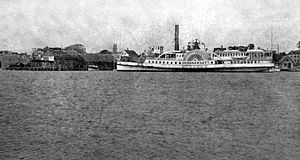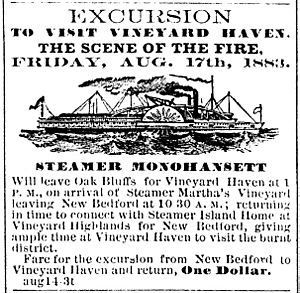Monohansett (steamboat) facts for kids



The Monohansett was a special type of boat called a sidewheel steamer. This means it had large paddle wheels on its sides that pushed it through the water. It worked as a ferry, carrying people and supplies to the island of Martha's Vineyard in the late 1800s. The boat was named after Monohansett Island, a small island near Naushon Island.
Contents
Building the Monohansett
The Monohansett was built in 1862. It was made by the New Bedford, Martha's Vineyard, & Nantucket Steamboat Company. They needed a new boat because their old one, the Eagle′s Wing, had caught fire and was destroyed in 1861. The engine from the old Eagle′s Wing was saved and put into the new Monohansett.
It took only five months to build the Monohansett. It was built in New York by Thomas Collier. Captain Benjamin C. Cromwell from Vineyard Haven, Massachusetts, designed the boat and watched over its building.
The Monohansett was about 55 meters (182 feet) long. It was about 8.5 meters (28 feet) wide. Its deepest part was about 2.9 meters (9 feet 6 inches). The bottom part of the boat, called the keel, was made of strong white oak. Its deck timbers were made of oak and white chestnut. The top parts of the boat were made from a type of tree called hackmatack and white chestnut. The Monohansett made its first trip to Martha's Vineyard on June 1, 1862, arriving at the Edgartown wharf.
Service During the Civil War
Just two months after it was built, on August 13, 1862, the United States Government rented the Monohansett. This was during the American Civil War. The Monohansett was used to deliver important messages to United States Navy ships. These ships were sailing in the Atlantic Ocean near Cape Hatteras and Wilmington, North Carolina. It also served in the Chesapeake Bay and the Potomac River.
While the Monohansett was helping in the war, a smaller boat called the Helen Augusta took its place as the ferry to Martha's Vineyard. By the end of the war in April 1865, the Monohansett was being used as a special boat for the headquarters at City Point, Virginia.
General Ulysses S. Grant, a very important leader in the war, used the Monohansett as a dispatch boat to send messages. People said that General Grant really liked the Monohansett. Even President Abraham Lincoln and his wife spent time on board the ship.
Martha's Vineyard Ferry Service
After the Civil War ended, the Monohansett returned to its job as a ferry for Martha's Vineyard in June 1865. In the summer of 1874, Ulysses S. Grant, who was now President, used the Monohansett to visit Martha's Vineyard. He arrived in a town called Cottage City, which is now known as Oak Bluffs.
The first captain of the Monohansett was Captain Benjamin C. Cromwell, who had designed the boat. During the Civil War, Captain Hiram Crowell was in charge. In 1867, Captain Charles C. Smith became the captain of the Monohansett. He had been the first mate under Captain Crowell during the war. He was still the captain in 1885. Later, Captain Francis J. Marshall also commanded the Monohansett. He also commanded other steamboats like the Martha's Vineyard and the Uncatena.
Even though the Monohansett mainly served Martha's Vineyard, it sometimes traveled to Nantucket. This was especially true in winter when the water would freeze. The Monohansett would break through the ice to help the people of Nantucket, who were often cut off from the mainland.
Final Years of the Monohansett
The Monohansett was sold either in 1901 or 1903 (the exact year is not clear). After that, it was used around Boston and the North Shore area of Massachusetts.
On August 3, 1904, the Monohansett was in a thick fog. It crashed into Little Misery Island, which is part of the Misery Islands in Salem Harbor, Massachusetts. The boat was on its way to Boston from Gloucester, Massachusetts, when it was wrecked.

